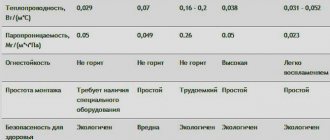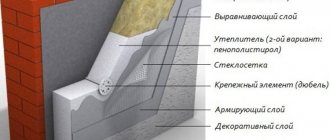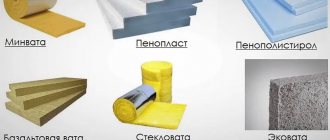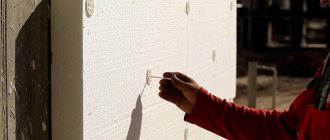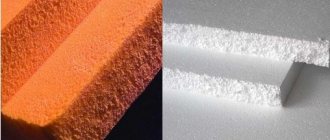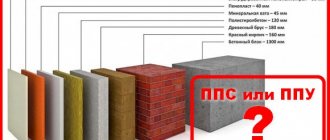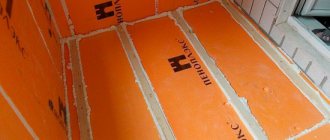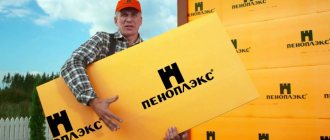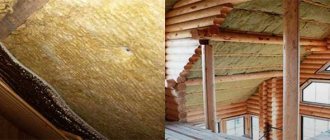Low density and light weight, excellent thermal characteristics and good sound insulation make polystyrene foam one of the most popular thermal insulation materials. Modern technologies make it possible to produce various types of foam, which differ in characteristics, cost and purpose. Knowing the differences will help you choose the optimal material for various jobs.
Polystyrene foam is, first of all, an excellent heat and sound insulator. A small layer of such a heat insulator can retain heat inside buildings even in the coldest winters. Almost everything can be insulated with this material: external and internal walls, roofs, floors and even pipelines. Due to its low weight, even a thick layer of foam does not exert a significant load on the floors, supporting structures or foundation.
Foam plastic, its types, production
Each of you, when you hear the word polystyrene foam, imagine in your head a picture of small white round balls combined into a single weightless block. Let's look at what polystyrene foam is.
Polystyrene foam is not just one type of raw material. Polystyrene foam is plastic saturated with air particles. Depending on the type of foam used, its scope of application changes.
The foam manufacturing technology consists of three main stages:
- Connection of components.
- Saturation of the composition with oxygen
- Form formation.
An important point in the production of polystyrene foam is the saturation of the composition with oxygen, or, as it is also called foaming. How intensely the composition is saturated with oxygen affects the scope of application and type of foam.
Another important factor in the thermal conductivity of polystyrene foam is its ability to absorb moisture. The less the foam absorbs water, the higher its ability to retain heat.
According to production technology, there are two types of polystyrene foam:
- Foamed polystyrene foam;
- Extruded polystyrene foam.
Links
- [www.youtube.com/watch?v=tNNRpMq0UAw Obtaining polystyrene foam, video]
- [penoplast.biz.ua/penoplast/plotnost-penoplasta.html Foam density]
| : Incorrect or missing image | To improve this article it is desirable:
|
Expanded polystyrene foam
The most common type of foam used in everyday life. It is used for transporting furniture or various household items for safety. It is used as insulation.
The composition is saturated with gases by foaming.
- Expanded polystyrene is made according to the following principle.
- Initially, foam particles are mixed, and carbohydrate particles are added to them to foam the composition.
- Special additives are also added to improve the quality of the finished product.
- It is possible to add various dyes and form granules. The finished mixture is steamed and the final shape is formed.
What it is?
Penoizol is a modified polystyrene foam. Its consistency resembles marshmallow. The material is foamed plastic with a cellular structure. Modified polystyrene foam is a modern heat insulator for insulating building structures.
Often the material is prepared directly on the construction site. Using specialized equipment, the liquid mixture is used to fill voids in walls, ceilings, roofs and attics. Thanks to the production of insulation at a construction site, money, time and effort are saved on the delivery of conventional insulation and its loading and unloading operations. No additional space is required for storing thermal insulation products.
Extruded polystyrene foam
The manufacturing technology differs from foaming in that the finished mixture is not doused with steam. Individual granules are not formed from the finished composition. Carbon dioxide is used as a foaming element.
The appearance of the sheet has a continuous structure with closed porous cells.
If we look at the structure of the foam in more detail, we can understand that 2% is solids and 98% is air, enclosed in small chambers.
Flaws:
- limited mechanical strength necessitates the formation of protection after installation;
- is destroyed upon contact with paints and varnishes and nitro paints;
- building material can be damaged by rodents, so it must be covered with substances that are less attractive to animals;
- the material almost does not allow air to pass through, which makes it necessary to equip the building with ventilation systems;
- Applying plaster to foam requires preliminary preparation to ensure better adhesion.
Main types of expanded polystyrene
Let's look at different types of polystyrene foam.
- Pressless. The foam granules are dried at a temperature of 80 degrees and foamed. This action is repeated several times. Then fill the form. More fragile look.
- Extruded.
- Extrusion. It is used in the food industry.
- Pressed. Quite durable looking.
- Autoclave.
Chemical properties
The operational parameters of the material that determine durability under the influence of external factors include:
- chemical resistance - polystyrene foam is impervious to many substances, except solvents and oxidizing acids. Mixtures based on acetone, ethers and light hydrocarbons quickly dissolve foam, without leaving even visible traces of it. Foam plastic is moderately resistant to alkalis, however, it is still not worth specially exposing them to them;
- temperature resistance – foam plastic has a low temperature limit of destruction. Already at 60-70 °C, gases begin to be released from it, which are products of the destruction of the original polymer. At temperatures above 100 °C, the decomposition of polystyrene occurs especially intensively and is accompanied by an even greater amount of toxic emissions. Serious consequences on the body can occur even several days after inhalation.
The fire safety of polystyrene foam is interpreted in two ways by supporters and opponents of the material. The first claim about its high resistance to flame, arguing that the ignited foam practically does not support the fire without an external heat source. The latter complain about the release of large amounts of gases during a fire that are harmful to humans. When viewed objectively, polystyrene foam is a fairly flammable substance that requires proper handling when finishing buildings.
Video: Foam plastic (expanded polystyrene, EPS, EPS). Advantages and disadvantages.
Advantages of expanded polystyrene
- Retains heat well
- Long service life. At temperature readings from -40 to +40 it can last for 50 years.
- Resistant to moisture.
- Microorganisms, various bacteria, mold and mildew do not develop.
- Non-toxic. It can also be used in the food industry.
- Very light.
- Foam plastic with a thickness of 3 cm can be used as a good sound insulator.
- Some types have a fire-resistant coating.
Comparative characteristics of the service life of insulation materials table
There are many types of insulation, but today we will take a closer look at the most budget-friendly and reliable options. These include:
- Mineral wool.
- Basal wool.
- Styrofoam.
| Name | Life time |
| Mineral wool | 25-40 years |
| Basal wool | 40-50 years |
| Expanded polystyrene | 30-50 years |
| Polyurethane foam | 20-50 years |
| Foam glass | 80-100 years |
The first type is called stone. It has a fairly high level of quality, as it is made from basalt stone. Its cost is much higher, but both the quality and the period of suitability meet expectations. According to statistics, mineral wool is used most often in construction. Duration of operation is about 50 years. But this figure is still disputed, and it has several nuances. At the moment there are two types of mineral wool.
The second is slag. This means that water practically cannot penetrate into it, and the material itself is quite dense. Accordingly, it is made from slag from the metallurgical industry. It is significantly inferior to the previous one in price, quality, and service life. In addition, it is not resistant to sudden temperature changes and may become deformed after a certain time. But despite this, it is often used as the best option if the construction is temporary or less significant.
Of course, for larger structures it is recommended to use stone wool. It may be more expensive, but when it comes to safety and quality, savings are out of the question.
It is worth noting that this substance has two important advantages:
Non-flammability. You don’t have to worry that the material is not susceptible to fire from metal tiles, which can heat up to high levels in extreme heat. And also other effects of high temperatures will not pose a threat to the insulation, and therefore to you.
Vapor permeability
Izover has the ability to “breathe,” which is also important. The material easily passes all vapors through itself, but at the same time they do not accumulate inside
This property makes mineral wool environmentally friendly, and in combination with thermal insulation it is a huge plus. In addition, no additional treatment is required for condensate.
Basal cotton wool is not inferior in the duration of the action of the previous substance. Manufacturers provide a warranty of over 50 years. A very long time ago, construction began to use insulation made from fibrous material. But the peak of its exploitation has occurred in the last couple of decades. This happened due to the intensive construction of country houses, as well as increased heating prices. This is where the material is very popular.
Over time, the quality of basal wool has improved significantly. Now it is an environmentally friendly and safe product. The main advantages include several aspects:
- Fire safety. The material can easily withstand high temperatures without losing its properties.
- Low hydrophobicity. The substance repels moisture, which significantly increases the service life of the insulation.
- Compressibility. Basal wool is very resistant and does not undergo deformation.
- Chemical resistance. Rotting, fungus, rodents, mold and harmful microorganisms will no longer become a threat to your home.
Despite the coincidence, the materials are of excellent quality, do not deform or crumble. The substances are used everywhere and have many positive reviews. With such insulation, your walls can last for more than 100 years.
Foam plastic for insulation
In order to keep the house warm during the cold season, the house is additionally insulated with polystyrene foam. The best polystyrene foam for insulation is considered to be PSB-S-25.
This brand is chosen because of the following qualities:
- Dense material that can be installed on any surface.
- Retains heat quite well.
- Small mass.
- Tolerates transportation well.
- Acceptable price.
- Long service life.
Peculiarities
This building material is widely used due to the following qualities:
- the ease of processing of building materials allows you to create structures of any geometry, even the most complex;
- low strength and high compressive density;
- it maintains structure stability in a wide temperature range: from -170 to +80 degrees;
- high resistance to many chemicals and biological factors;
- high thermal insulation allows us to consider polystyrene foam insulation an excellent building material, for example, for the construction of modern multi-layer house structures;
- environmentally friendly building material, since it does not contain substances that are toxic or harmful to human health;
- easy to process and install, including using conventional construction adhesives.
- the price of non-extruded foam is lower than that of EPS.
Application of façade foam plastic
Facade foam is used in two cases. It is used as a base for plaster or as an independent coating that performs both insulating and decorative functions.
As a base for plaster, polystyrene foam is installed on the wall using cement glue. It is designed specifically for these purposes. It must be diluted in small portions with water. Within 30 minutes the glue sets. You need to work quickly.
- Glue is applied to the surface of the foam sheet and secured to the surface by pressing the sheet firmly. There is no need to apply glue to the side edges.
- After which the sheet is additionally secured using snipe umbrellas. IN
- Make a hole in the canvas and then install an umbrella. There must be at least five umbrellas per 1m2.
- After which the foam sheet is covered with a layer of cement glue. For better adhesion and improved strength of the structure, it is additionally reinforced with reinforced mesh.
- A mesh is installed on the not dried layer of glue, and with light movements it is embedded in the composition.
After the first layer of cement glue has dried, it is coated again, completely hiding the mesh. This coating must be coated with a primer and any plaster.
In its pure form, foam does not tolerate UV rays. For a longer service life, it must be coated with a protective layer. You can purchase already coated decorative sheets for the facade.
Criterias of choice
In order to decide which of the materials under consideration is best suited for specific conditions, it is necessary to take into account the following criteria:
- What types of work will be carried out with it.
- Characteristics of the material according to GOST and other standards.
- Resistance to destructive factors arising at the site of application.
- Features of products of specific brands.
Note! When choosing a thermal insulation material, it is necessary to take into account that the main difference between polystyrene and foam plastic is that the first is not afraid of moisture, fire, is more durable and accurate in size, and in most cases has a locking system at the edges that prevents the formation of cold bridges.
Video review on how to properly insulate with polystyrene foam and expanded polystyrene:
Foam glue
Basically, foam plates are attached to the surface using glue. You need to choose glue for suitable conditions. If you attach it to the facade of a building, the glue must withstand temperature changes.
Adhesive for foam plastic should not contain gasoline or acetone, as they destroy the structure of the foam plastic. The glue is also selected for the surface on which the foam sheet will be attached.
Foam glue can be either dry or wet.
- To avoid making a mistake with your choice, you should not take the cheapest glue.
- It is better to spend a little more money, but get a product with detailed instructions and composition in accordance with GOST.
- When purchasing a dry mixture, pay attention to whether the packaging is damaged.
- Is the mixture really dry? Slight moisture may change the properties of the adhesive.
Polymers suitable for foaming and blowing agents
Most known polymers can be filled with gases to produce foam plastic. At the same time, the industry produces large-scale foam plastics mainly on the basis of polystyrene (foamed polystyrene, EPS), polyethylene (foamed PE), polyvinyl chloride (foamed PVC), polyurethanes (PPU), polypropylene (foamed PP). Less commonly used are polyreactive materials, like polyurethane foam, such as epoxy, urea, phenolic resins, as well as organosilicon polymers.
Mainly, when foaming in industry, the following gas generators are used: containing nitrogen (azo compounds, nitro compounds, ammonium carbonate, etc.) and low-boiling liquids - isopentane, varieties of freon, methylene chloride.
